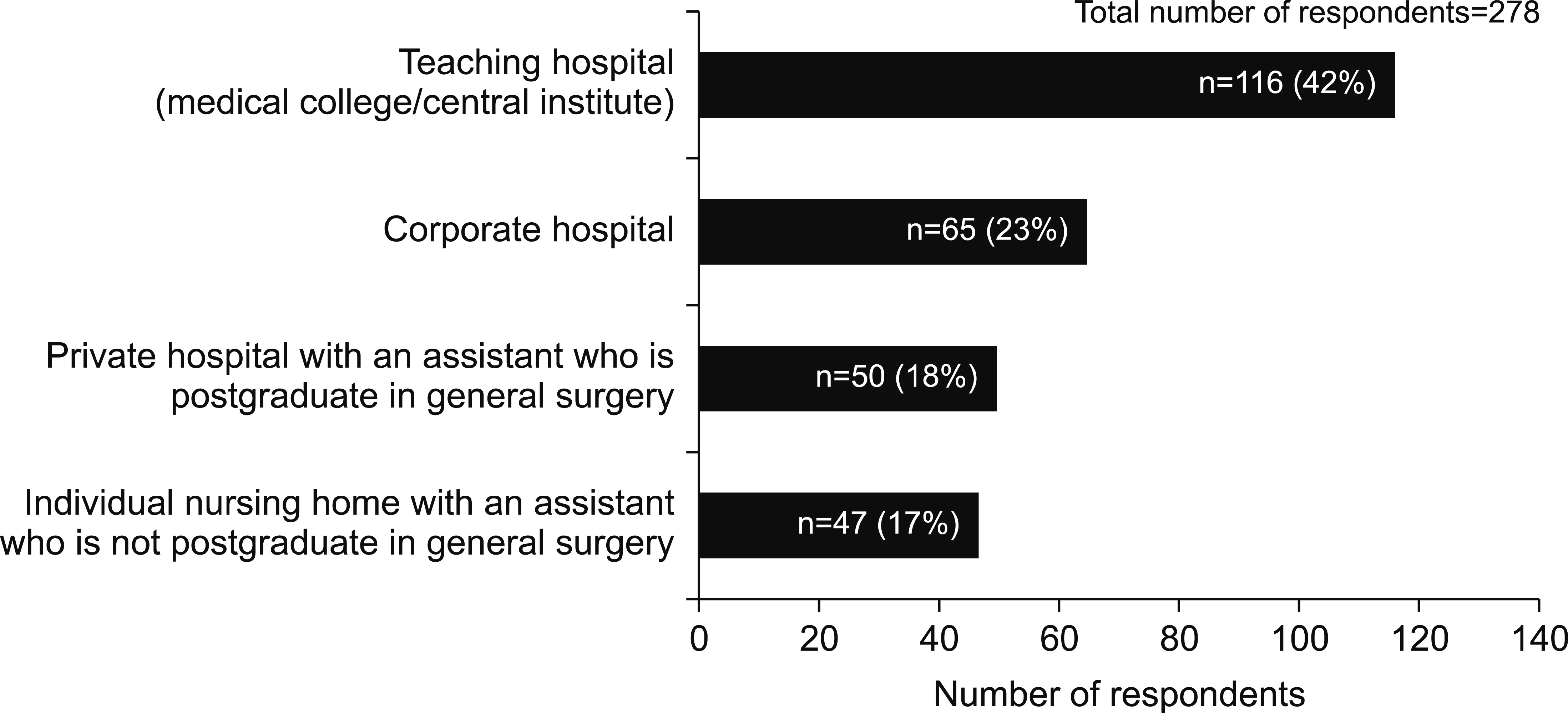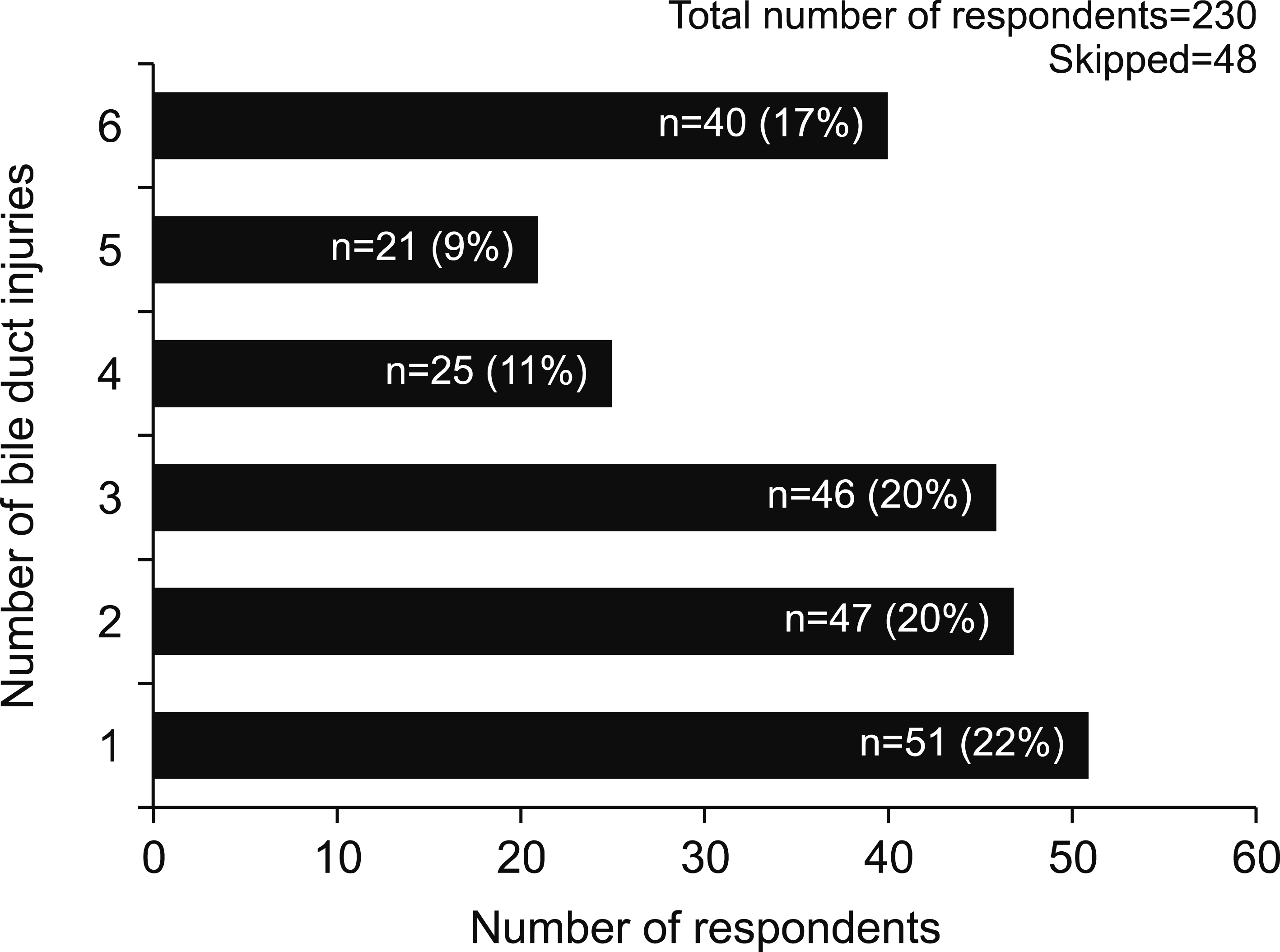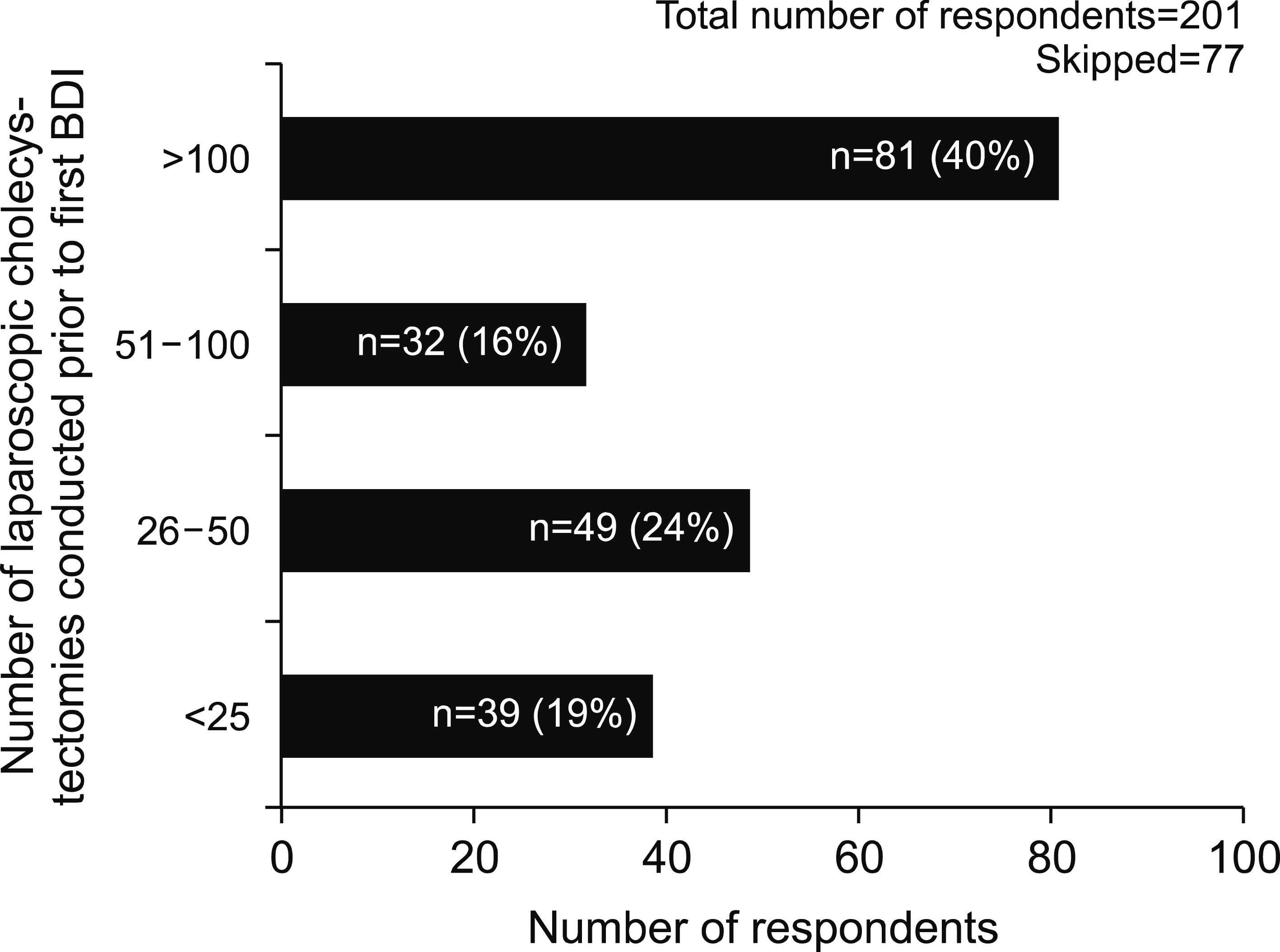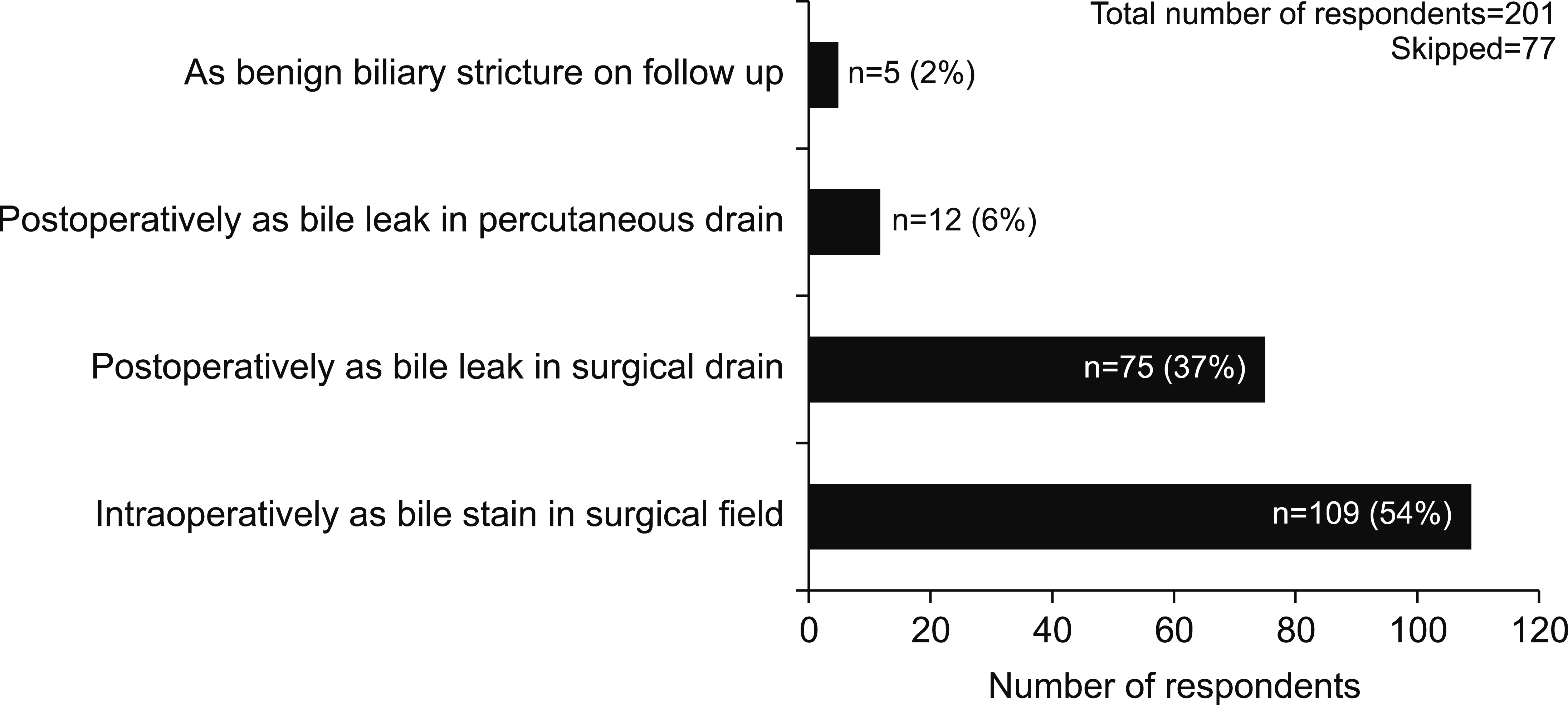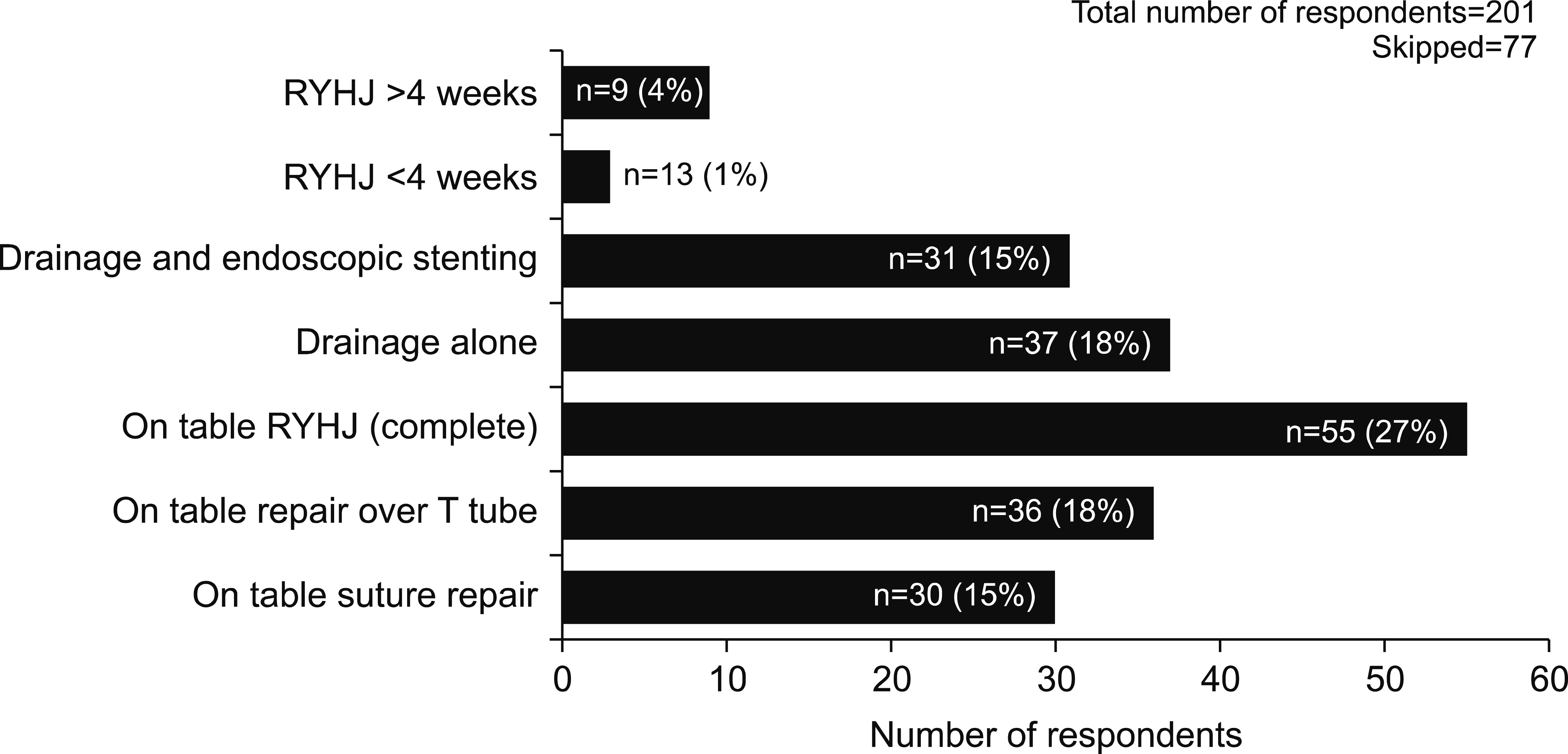Ann Hepatobiliary Pancreat Surg.
2020 Nov;24(4):469-476. 10.14701/ahbps.2020.24.4.469.
Bile duct injury during laparoscopic cholecystectomy: An Indian e-survey
- Affiliations
-
- 1Department of Surgical Gastroenterology, Sanjay Gandhi Postgraduate Institute of Medical Sciences, Lucknow, UP, India
- KMID: 2508856
- DOI: http://doi.org/10.14701/ahbps.2020.24.4.469
Abstract
- Backgrounds/Aims
In the absence of national registry of laparoscopic cholecystectomy (LC) or its complications, it is impossible to determine incidence of bile duct injury (BDI) in India. We conducted an e-survey among practicing surgeons to determine prevalence and management patterns of BDI in India. Our hypothesis was that majority of surgeons would have experienced a BDI during LC despite large experience and that most surgeons who have a BDI tend to manage it themselves.
Methods
An 18-question e-survey of practicing laparoscopic surgeons in India was done.
Results
278/727 (38%) surgeons responded. 240/278 (86%) respondents admitted to a BDI during LC and 179/230 (78%) affirmed to more than one BDI. A total of 728 BDIs were reported. 36/230 (15%) respondents experienced their first BDI even after >10 years of practice and 40% had their first BDI even after having performed >100 LCs. 161/201 (80%) of the respondents decided to manage the BDI themselves, including 56/99 (57%) non-biliary surgeons and 44/82 (54%) surgeons working in non-biliary center. 37/201 (18%) respondents admitted to having a mortality arising out of a BDI; the mortality rate of BDI was 37/728 (5%) in this survey. Only 13/201 (6%) respondents have experienced a medico-legal case related to a BDI during LC.
Conclusions
Prevalence of BDI is high in India and occurs despite adequate experience and volume. Even inexperienced non-biliary surgeons working in non-biliary centers attempt to repair the BDI themselves. BDI is associated with significant mortality but litigation rates are fortunately low in India.
Figure
Reference
-
1. Fong ZV, Pitt HA, Strasberg SM, Loehrer AP, Sicklick JK, Talamini MA, et al. 2018; Diminished survival in patients with bile leak and ductal injury: management strategy and outcomes. J Am Coll Surg. 226:568–576. e1. DOI: 10.1016/j.jamcollsurg.2017.12.023. PMID: 29307612. PMCID: PMC6053912.
Article2. Törnqvist B, Strömberg C, Persson G, Nilsson M. 2012; Effect of intended intraoperative cholangiography and early detection of bile duct injury on survival after cholecystectomy: population based cohort study. BMJ. 345:e6457. DOI: 10.1136/bmj.e6457. PMID: 23060654. PMCID: PMC3469410.
Article3. Waage A, Nilsson M. 2006; Iatrogenic bile duct injury: a population-based study of 152 776 cholecystectomies in the Swedish Inpatient Registry. Arch Surg. 141:1207–1213. DOI: 10.1001/archsurg.141.12.1207. PMID: 17178963.4. Pucher PH, Brunt LM, Davies N, Linsk A, Munshi A, Rodriguez HA, et al. 2018; Outcome trends and safety measures after 30 years of laparoscopic cholecystectomy: a systematic review and pooled data analysis. Surg Endosc. 32:2175–2183. DOI: 10.1007/s00464-017-5974-2. PMID: 29556977. PMCID: PMC5897463.5. Archer SB, Brown DW, Smith CD, Branum GD, Hunter JG. 2001; Bile duct injury during laparoscopic cholecystectomy: results of a national survey. Ann Surg. 234:549–558. discussion 558-559. DOI: 10.1097/00000658-200110000-00014. PMID: 11573048. PMCID: PMC1422078.6. Francoeur JR, Wiseman K, Buczkowski AK, Chung SW, Scudamore CH. 2003; Surgeons' anonymous response after bile duct injury during cholecystectomy. Am J Surg. 185:468–475. DOI: 10.1016/S0002-9610(03)00056-4. PMID: 12727569.
Article7. Nuzzo G, Giuliante F, Giovannini I, Ardito F, D'Acapito F, Vellone M, et al. 2005; Bile duct injury during laparoscopic cholecystectomy: results of an Italian national survey on 56 591 cholecystectomies. Arch Surg. 140:986–992. DOI: 10.1001/archsurg.140.10.986. PMID: 16230550.8. Rystedt J, Lindell G, Montgomery A. 2016; Bile duct injuries associated with 55,134 cholecystectomies: treatment and outcome from a national perspective. World J Surg. 40:73–80. DOI: 10.1007/s00268-015-3281-4. PMID: 26530691.
Article9. Gordon-Weeks A, Samarendra H, de Bono J, Soonawalla Z, Silva M. 2017; Surgeons opinions of legal practice in bile duct injury following cholecystectomy. HPB (Oxford). 19:721–726. DOI: 10.1016/j.hpb.2017.04.012. PMID: 28526400.
Article10. Iwashita Y, Hibi T, Ohyama T, Umezawa A, Takada T, Strasberg SM, et al. 2017; Delphi consensus on bile duct injuries during laparoscopic cholecystectomy: an evolutionary cul-de-sac or the birth pangs of a new technical framework? J Hepatobiliary Pancreat Sci. 24:591–602. DOI: 10.1002/jhbp.503. PMID: 28884962.11. Eysenbach G. 2004; Improving the quality of web surveys: the Checklist for Reporting Results of Internet E-Surveys (CHERRIES). J Med Internet Res. 6:e34. DOI: 10.2196/jmir.6.3.e34. PMID: 15471760. PMCID: PMC1550605.
Article12. McMahon AJ, Fullarton G, Baxter JN, O'Dwyer PJ. 1995; Bile duct injury and bile leakage in laparoscopic cholecystectomy. Br J Surg. 82:307–313. DOI: 10.1002/bjs.1800820308. PMID: 7795992.
Article13. Gigot J, Etienne J, Aerts R, Wibin E, Dallemagne B, Deweer F, et al. 1997; The dramatic reality of biliary tract injury during laparoscopic cholecystectomy. An anonymous multicenter Belgian survey of 65 patients. Surg Endosc. 11:1171–1178. DOI: 10.1007/s004649900563. PMID: 9373288.14. Calvete J, Sabater L, Camps B, Verdú A, Gomez-Portilla A, Martín J, et al. 2000; Bile duct injury during laparoscopic cholecystectomy: myth or reality of the learning curve? Surg Endosc. 14:608–611. DOI: 10.1007/s004640000103. PMID: 10948294.15. The Southern Surgeons Club. 1991; A prospective analysis of 1518 laparoscopic cholecystectomies. N Engl J Med. 324:1073–1078. DOI: 10.1056/NEJM199104183241601. PMID: 1826143.16. Fullum TM, Downing SR, Ortega G, Chang DC, Oyetunji TA, Van Kirk K, et al. 2013; Is laparoscopy a risk factor for bile duct injury during cholecystectomy? JSLS. 17:365–370. DOI: 10.4293/108680813X13654754535638. PMID: 24018070. PMCID: PMC3771752.
Article17. Way LW, Stewart L, Gantert W, Liu K, Lee CM, Whang K, et al. 2003; Causes and prevention of laparoscopic bile duct injuries: analysis of 252 cases from a human factors and cognitive psychology perspective. Ann Surg. 237:460–469. DOI: 10.1097/01.SLA.0000060680.92690.E9. PMID: 12677139. PMCID: PMC1514483.18. Strasberg SM, Hertl M, Soper NJ. 1995; An analysis of the problem of biliary injury during laparoscopic cholecystectomy. J Am Coll Surg. 180:101–125. PMID: 8000648.19. Halbert C, Pagkratis S, Yang J, Meng Z, Altieri MS, Parikh P, et al. 2016; Beyond the learning curve: incidence of bile duct injuries following laparoscopic cholecystectomy normalize to open in the modern era. Surg Endosc. 30:2239–2243. DOI: 10.1007/s00464-015-4485-2. PMID: 26335071.
Article20. Mangieri CW, Hendren BP, Strode MA, Bandera BC, Faler BJ. 2019; Bile duct injuries (BDI) in the advanced laparoscopic cholecystectomy era. Surg Endosc. 33:724–730. DOI: 10.1007/s00464-018-6333-7. PMID: 30006843.
Article21. Harboe KM, Bardram L. 2011; The quality of cholecystectomy in Denmark: outcome and risk factors for 20,307 patients from the national database. Surg Endosc. 25:1630–1641. DOI: 10.1007/s00464-010-1453-8. PMID: 21136118.
Article22. Pottakkat B, Vijayahari R, Prasad KV, Sikora SS, Behari A, Singh RK, et al. 2009; Surgical management of patients with post-cholecystectomy benign biliary stricture complicated by atrophy-hypertrophy complex of the liver. HPB (Oxford). 11:125–129. DOI: 10.1111/j.1477-2574.2008.00017.x. PMID: 19590635. PMCID: PMC2697878.
Article23. Javed A, Shashikiran BD, Aravinda PS, Agarwal AK. 2020; Laparoscopic versus open surgery for the management of post-cholecystectomy benign biliary strictures. Surg Endosc. doi: 10.1007/s00464-020-07496-6. [in press]. DOI: 10.1007/s00464-020-07496-6. PMID: 32179999.
Article24. Stewart L, Way LW. 1995; Bile duct injuries during laparoscopic cholecystectomy. Factors that influence the results of treatment. Arch Surg. 130:1123–1128. discussion 1129. DOI: 10.1001/archsurg.1995.01430100101019. PMID: 7575127.25. Bansal VK, Misra M, Agarwal AK, Agrawal JB, Agarwal PN, Aggarwal S, et al. 2019; SELSI consensus statement for safe cholecystectomy-prevention and management of bile duct injury-Part B. Indian J Surg. doi: 10.1007/s12262-019-01994-1. [in press]. DOI: 10.1007/s12262-019-01994-1.
Article26. Kapoor VK. 2016; Medico-legal aspects of bile duct injury. J Minim Access Surg. 12:1–3. DOI: 10.4103/0972-9941.169995. PMID: 26917911. PMCID: PMC4746967.
Article27. Deziel DJ, Millikan KW, Economou SG, Doolas A, Ko ST, Airan MC. 1993; Complications of laparoscopic cholecystectomy: a national survey of 4,292 hospitals and an analysis of 77,604 cases. Am J Surg. 165:9–14. DOI: 10.1016/S0002-9610(05)80397-6. PMID: 8418705.
Article28. Alves A, Farges O, Nicolet J, Watrin T, Sauvanet A, Belghiti J. 2003; Incidence and consequence of an hepatic artery injury in patients with postcholecystectomy bile duct strictures. Ann Surg. 238:93–96. DOI: 10.1097/01.sla.0000074983.39297.c5. PMID: 12832970. PMCID: PMC1422668.
Article29. Gouma DJ, Go PM. 1994; Bile duct injury during laparoscopic and conventional cholecystectomy. J Am Coll Surg. 178:229–233. PMID: 8149013.30. Mishra PK, Saluja SS, Nayeem M, Sharma BC, Patil N. 2015; Bile duct injury-from injury to repair: an analysis of management and outcome. Indian J Surg. 77(Suppl 2):536–542. DOI: 10.1007/s12262-013-0915-3. PMID: 26730060. PMCID: PMC4692882.
Article31. Booij KAC, de Reuver PR, van Dieren S, van Delden OM, Rauws EA, Busch OR, et al. 2018; Long-term impact of bile duct injury on morbidity, mortality, quality of life, and work related limitations. Ann Surg. 268:143–150. DOI: 10.1097/SLA.0000000000002258. PMID: 28426479.
Article
- Full Text Links
- Actions
-
Cited
- CITED
-
- Close
- Share
- Similar articles
-
- Recent classifications of the common bile duct injury
- Clinical Experiences of Management of Bile Duct Injuries during Laparoscopic Cholecystectomy
- Relationship between the risk of bile duct injury during laparoscopic cholecystectomy and the types of preoperative magnetic resonance cholangiopancreatiocography (MRCP)
- Laparoscopic cholecystectomy and common bile duct exploration for gallstone and common bile duct stone in a patient with a left-sided gallbladder: a case report
- Intraoperatively malpositioned stent as a complication of common bile duct injury during laparoscopic cholecystectomy

